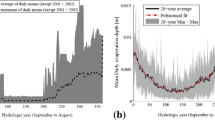Abstract
This paper describes a melding of an established set of hydrological component processes to obtain a full-scale model for reservoir sedimentation. The goal is to achieve a probabilistic system relating reservoir sedimentation to standard injection, river flow, particle transport, and dam storage subsystems. In the conclucing section, it is found that for a certain assembly of process components, the sedimentation process is Poisson, with parameters interpretable in terms of physical variables. Moreover, for the resulting parameters, a Gaussian approximation can confidently be adopted.
Similar content being viewed by others
Abbreviations
- CAP:
-
initial capacity of the reservoir
- D :
-
particle volume
- F :
-
(cumulative) distribution function (of subscripted variable)
- G(v):
-
conversion of river velocity to volume
- K(t):
-
current reservoir capacity
- L :
-
distance from sediment source to the reservoir
- N(t):
-
number of particles injected at timet
- R():
-
the release law
- S(t):
-
reservoir storage at timet
- SED(t):
-
amount of sediment deposited by timet
- T :
-
time from injection to reservoir entry
- T end :
-
lifetime of the reservoir
- v :
-
velocity at a given time
- v:
-
history of velocities
- x :
-
distance along river reach
- Z(t):
-
indicator of whether a particle has been deposited.
References
Ashida, K. and Fujita, M., 1986, Stochastic model for particle suspension in open channels,J. Hydrosci. Hydraulic Eng. 4, 21–46.
Duckstein, L., Szidarovszky, F., and Yakowitz, S., 1977, Bayes decision of a reservoir under random sediment yield,Water Resour. Res. 13, 713–719.
Feller, William, 1966,An Introduction to Probability Theory and Its Applications, Vol. 2, John Wiley, New York.
Feller, William, 1968,An Introduction to Probability Theory and Its Applications, Vol. 1, 3rd edn., John Wiley, New York.
Gani, J., 1957, Problems in the probability theory of storage systems,J. R. Statist. Soc. B 19, 181–206.
Gani, J., 1969, Recent advances in storage and flooding theory,Adv. Appl. Prob. 1, 90–110.
Gani, J. and Prabhu, N. U., 1963, A storage model with continuous infinitely divisible inputs,Proc. Camb. Phil. Soc. 59, 417–429.
Gani, J. and Todorovic, P., 1983, A model for the transport of solid particles in a fluid flow,Stoch. Proc. Applns. 14, 1–17.
Gani, J. and Todorovic, P., 1987a, On the persistent release of particles in a fluid flow, in A. E. Geland (ed.),Contributions to the Theory and Applications of Statistics, a Volume in Honor of Herbert Solomon, Academic Press, New York, pp. 43–74.
Gani, J. and Todorovic, P., 1987b, Transport and Sedimentation of particles in a fluid flow,Stoch. Hydrology and Hydraulics 1, 209–216.
Gani, J. P., Todorovic, P., and Yakowitz, S., 1987, Silting of dams by sedimentary particles,Math. Scientist 12, 81–90.
Garde, R. J. and Ranga Raju, K. G., 1985,Mechanics of Sediment Transportation and Alluvial Stream Problems, 2nd edn., Halsted Press, New York.
Graf, W., 1983, The hydraulics of reservoir sedimentation,Water Power and Dan Construction, April, 45–52.
Gries, M. J. 1983, Flood frequency analysis: A review of 1979–1982,Rev. Geophys. Space Phys. 21, 699–706.
Llamas, J. and Nzakimuena, J., 1987, Dynamique des suspensions: analysis statistique,Rev. Internat. Sci. de L'eau 3, 19–31.
Matyas, E. L. and Rothenburg, L., 1986, Characteristics of sediment profiles in reservoirs,J. Hydrology 87, 33–34.
Moran, P. A. P., 1959,A Theory of Storage, Methuen, London.
Soares, E. F., Unny, T. E., and Lennox, W. C., 1982a, Conjunctive use of deterministic models for predicting sediment storage in large reservoirs 1,J. Hydraulic Eng. 59, 49–82.
Soares, E. F., Unny, T. E., and Lennox, W. C., 1982b, Conjunctive use of deterministic models for predicting sediment storage in large reservoirs 2,J. Hydraulic Eng. 59, 83–105.
Soares, E. F., Unny, T. E., and Lennox, W. C., 1982c, Conjunctive use of deterministic models for predicting sediment storage in large reservoirs 3,J. Hydraulic Eng. 59, 107–121.
Szidarovszky, F. and Yakowitz, S., 1976a, Analysis of flooding for an open channel subject to random inflow and blockage,J. Hydrol. Sci. 3, 93–103.
Szidarovszky, F., Yakowitz, S., and Krysztofowicz, R., 1976b, A Bayes approach for simulating sediment yield,J. Hydrol. Sci. 3, 33–45.
Todorovic, P., 1975, A stochastic model of dispersion of sediment particles released from a continuous source,Water Resour. Res. 11 (6).
Todororic, P., 1979, A probabilistic approach to flood analysis,Proc. 42nd Session ISI 48, 113–124.
Todorovic, P., 1982, Stochastic analysis of rainfall and funoff,Proc. Int. Symp. Rainfall Runoff Modelling, Water Res., Littleton Colo., 597–636.
Woolhiser, D. A. and Renard, K. G., 1979, Stochastic aspects of watershed sediment yield, in H. W. Shen and H. Kikkawa (eds.),Application of Stochastic Processes in Sediment Transport, Water Resources Res. Pub., Fort Collins, Colo.
Author information
Authors and Affiliations
Rights and permissions
About this article
Cite this article
Gani, J., Yakowitz, S. A probabilistic sedimentation analysis for predicting reservoir lifetime. Water Resour Manage 3, 191–203 (1989). https://doi.org/10.1007/BF00872342
Received:
Revised:
Issue Date:
DOI: https://doi.org/10.1007/BF00872342




